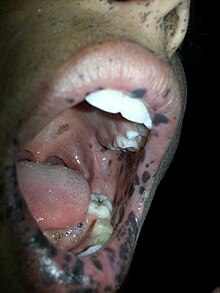Peutz-Jeghers Syndrome
| Classification according to ICD-10 | |
|---|---|
| Q85.8 | Other phacomatoses, not elsewhere classified |
| ICD-10 online (WHO version 2019) | |

The Peutz-Jeghers syndrome , also Hutchinson-Weber-Peutz syndrome or Peutz-Jeghers hamartosis , is a rare, genetically determined and autosomal - dominantly inherited gastrointestinal polyposis with characteristic pigment spots on the skin and mucous membranes. The disease is named after the internists Jan Peutz and Harold Jeghers . An early illustration in 1896 goes back to J. Hutchinson.
etiology
In Peutz-Jeghers syndrome there is a mutation of the serine - threonine - kinase STK11 on chromosome 19p13.3 . This is probably a tumor suppressor gene, the failure of which causes multiple tumors. A mutation of the STK11 kinase could be detected in 70% of all patients. The genetic penetrance is complete, but the expressivity is variable. Men and women are equally affected. Most cases are familial, but there are also sporadic cases.
The diagnosis is made through a biopsy. The skin spots in particular must also suggest Addison's disease or McCune-Albright syndrome .
The Cronkhite Canada Syndrome must be distinguished .
Symptoms
The disease is manifested by multiple benign polyps in the gastrointestinal tract , which are hamartomas . Histologically, branched smooth muscle cells with embedded glandular tissue are shown. There are often several hundred such hamartomas, which are detectable in 88% of patients. They are usually 1–5 mm in size, but can also get significantly larger. In 64% of patients, they are in the small intestine detectable in 64% also in the large intestine ( colon ), in 49% in the stomach and in 32% in the rectum ( rectal ). The hamartomatous polyps have rarely been described in the renal pelvis, bladder, lungs and nostrils.
The polyps are typically diagnosed between the 10th and 30th Year of life clinically manifest. In 43% of patients it manifests itself through an obstruction of the intestinal lumen up to the intestinal obstruction ( ileus ), in 23% through abdominal (colicky) pain, and in about 14% through rectal blood loss or bloody stool. Rarely (7%) does an anal extrusion of a polyp occur. Often there is also invagination of the intestine, mostly (95%) of the small intestine. Chronic bleeding can develop into secondary anemia .
In addition, almost all patients have melanotic pigment spots on the skin and mucous membranes, which are usually detectable by the age of two and increase in size and number by puberty. After that, the pigment spots slowly recede, but they never completely disappear. Localization on the lips and around the mouth is typical (in 94%), followed in frequency by involvement of the hands (74%), the oral mucosa (66%) and the feet (62%). The pigment spots are 1–5 mm in size.
So far, the Peutz-Jeghers syndrome was classified as a precancerous condition with a slightly increased risk of cancer; However, more recent studies have shown that there is an 85% life risk of developing cancer. About half of all patients die of cancer before the age of 60. The gastrointestinal area is particularly affected (57%), as well as the chest (45%). In addition, the risk of tumors of the ovaries, the cervix, the lungs, the pancreas, the uterus and the testicles is also increased.
therapy
There is no causal therapy, rather symptomatic treatment is given. In the case of intestinal invagination, a surgical procedure is recommended because of the underlying degeneration and the high risk of recurrence. A prophylactic removal of the hundreds of polyps is not possible; individual suspicious polyps can be removed ( polypectomy ). In addition, due to the risk of cancer, regular early detection examinations ( screening ) of v. a. of the gastrointestinal tract and breasts are recommended (e.g. by colonoscopy and mammography ), as well as monitoring of the other organs that are less likely to be affected.
Web links
Individual evidence
- ↑ TE Baudendistel, AK Haase, F. Fitzgerald: The leading diagnosis. In: N Engl J Med . 2007; 357, pp. 2389-2393.
- ↑ N. Hearle, V. Schumacher, FH Menko et al .: Frequency and spectrum of cancers in Peutz-Jeghers syndrome. In: Clin Cancer Res . 2006; 12, pp. 3209-3215.
